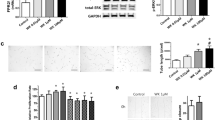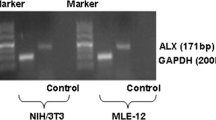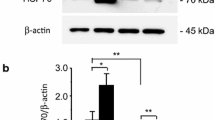Abstract
Bronchopulmonary dysplasia is characterized by prolonged oxygen dependency due to compromised gas-exchange capability. This is attributable mainly to inadequate and aberrant alveolarization resulting from insults like hyperoxia. Leukotrienes are associated with hyperoxia-induced inhibition of alveolarization. We hypothesized that a 5-lipoxygenase-activating protein (FLAP) inhibitor given while newborn mice were exposed to 85% oxygen would prevent aberrant alveolarization in a dose- and time-dependent manner. Newborn mice were exposed to either room air or hyperoxia for 14 days. Pups were treated with either vehicle or MK-0591 10, 20, or 40 mg/kg subcutaneously daily for days 1–4, 5–9, or 10–14. On day 14, the lungs were inflated, fixed, and stained for histopathological and morphometric analyses. Hyperoxia groups treated with MK-0591 20 or 40 mg/kg during days P1–P4 or P10–P14 showed alveolarization that resembled that of room air controls while untreated hyperoxia groups showed definite evidence of aberrant alveolarization but no inflammation. In a hyperoxia-exposed newborn mice model, a FLAP inhibitor given during critical window periods may prevent aberration of alveolarization in a dose- and time-dependent manner.


Similar content being viewed by others
Abbreviations
- BPD:
-
Bronchopulmonary dysplasia
- FLAP:
-
5-Lipoxygenase activating protein
- LAR:
-
Mean perimeter/area ratios (1/μm)
- LT:
-
Leukotriene
References
Coalson JJ, Winter V, deLemos RA (1995) Decreased alveolarization in baboon survivors with bronchopulmonary dysplasia. Am J Respir Crit Care Med 152:640–646
Jobe AH, Bancalari E (2001) Bronchopulmonary dysplasia. Am J Respir Crit Care Med 163:1723–1729
Albertine KH, Jones GP, Starcher BC, Bohnsack JF, Davis PL, Cho SC, Carlton DP, Bland RD (1999) Chronic lung injury in preterm lambs. Disordered respiratory tract development. Am J Respir Crit Care Med 159:945–958
Baraldi E, Filippone M (2007) Chronic lung disease after premature birth. N Engl J Med 357:1946–1955
Bhandari A, Bhandari V (2009) Pitfalls, problems, and progress in bronchopulmonary dysplasia. Pediatrics 123:1562–1573
Park MS, Rieger-Fackeldey E, Schanbacher BL, Cook AC, Bauer JA, Rogers LK, Hansen TN, Welty SE, Smith CV (2007) Altered expressions of fibroblast growth factor receptors and alveolarization in neonatal mice exposed to 85% oxygen. Pediatr Res 62:652–657
Manji JS, O’Kelly CJ, Leung WI, Olson DM (2001) Timing of hyperoxic exposure during alveolarization influences damage mediated by leukotrienes. Am J Physiol Lung Cell Mol Physiol 281:L799–L806
Takeda K, Hamelmann E, Joetham A, Shultz LD, Larsen GL, Irvin CG, Gelfand EW (1997) Development of eosinophilic airway inflammation and airway hyperresponsiveness in mast cell-deficient mice. J Exp Med 186:449–454
Frank L (1991) Hyperoxic inhibition of newborn rat lung development: protection by deferoxamine. Free Radic Biol Med 11:341–348
Boros V, Burghardt JS, Morgan CJ, Olson DM (1997) Leukotrienes are indicated as mediators of hyperoxia-inhibited alveolarization in newborn rats. Am J Physiol 272:L433–L441
Phillips GJ, Mohammed W, Kelly FJ (1995) Oxygen-induced lung injury in the pre-term guinea pig: the role of leukotriene B4. Respir Med 89:607–613
Taniguchi H, Taki F, Takagi K, Satake T, Sugiyama S, Ozawa T (1986) The role of leukotriene B4 in the genesis of oxygen toxicity in the lung. Am Rev Respir Dis 133:805–808
Warner BB, Stuart LA, Papes RA, Wispe JR (1998) Functional and pathological effects of prolonged hyperoxia in neonatal mice. Am J Physiol 275:L110–L117
Hosford GE, Koyanagi KS, Leung WI, Olson DM (2002) Hyperoxia increases protein mass of 5-lipoxygenase and its activating protein, flap, and leukotriene B(4) output in newborn rat lungs. Exp Lung Res 28:671–684
Kertesz NJ, Holtzman RB, Adler L, Hageman JR (1992) Evaluation of a leukotriene receptor antagonist in prevention of hyperoxic lung injury in newborn rabbits. Prostaglandins Leukot Essent Fatty Acids 45:159–165
Beller TC, Friend DS, Maekawa A, Lam BK, Austen KF, Kanaoka Y (2004) Cysteinyl leukotriene 1 receptor controls the severity of chronic pulmonary inflammation and fibrosis. Proc Natl Acad Sci USA 101:3047–3052
Bigby TD (2002) The yin and the yang of 5-lipoxygenase pathway activation. Mol Pharmacol 62:200–202
Leff AR (2001) Discovery of leukotrienes and development of antileukotriene agents. Ann Allergy Asthma Immunol 86:4–8
Medina L, Perez-Ramos J, Ramirez R, Selman M, Pardo A (1994) Leukotriene C4 upregulates collagenase expression and synthesis in human lung fibroblasts. Biochim Biophys Acta 1224:168–174
Nathan RA, Kemp JP (2001) Efficacy of antileukotriene agents in asthma management. Ann Allergy Asthma Immunol 86:9–17
Speer CP (1999) Inflammatory mechanisms in neonatal chronic lung disease. Eur J Pediatr 158(Suppl 1):S18–S22
Zeldin DC (2002) The 5-lipoxygenase pathway: a new therapeutic target for the treatment of pulmonary fibrosis. Am J Respir Crit Care Med 165:146–147
Funk AJ, Mandrell TD, Lokey SJ, Kosanke SD, Li CS, Potters CF (2007) Effects of leukotriene inhibition on pulmonary morphology in rat pup lungs exposed to hyperoxia. Comp Med 57:186–192
Rogers LK, Tipple TE, Nelin LD, Welty SE (2009) Differential responses in the lungs of newborn mouse pups exposed to 85% or >95% oxygen. Pediatr Res 65:33–38
Hokuto I, Perl AK, Whitsett JA (2004) FGF signaling is required for pulmonary homeostasis following hyperoxia. Am J Physiol Lung Cell Mol Physiol 286:L580–L587
Simonet WS, DeRose ML, Bucay N, Nguyen HQ, Wert SE, Zhou L, Ulich TR, Thomason A, Danilenko DM, Whitsett JA (1995) Pulmonary malformation in transgenic mice expressing human keratinocyte growth factor in the lung. Proc Natl Acad Sci USA 92:12461–12465
Tichelaar JW, Lu W, Whitsett JA (2000) Conditional expression of fibroblast growth factor-7 in the developing and mature lung. J Biol Chem 275:11858–11864
Acknowledgment
This study was supported by the Medical School Grant Program of Merck Sharp & Dohme Corp. The authors thank Hye Sun Yang for her excellent technical assistance throughout the experiments.
Author information
Authors and Affiliations
Corresponding author
Additional information
M. S. Park and M. H. Sohn contributed equally to this work.
Rights and permissions
About this article
Cite this article
Park, M.S., Sohn, M.H., Kim, KE. et al. 5-Lipoxygenase-Activating Protein (FLAP) Inhibitor MK-0591 Prevents Aberrant Alveolarization in Newborn Mice Exposed to 85% Oxygen in a Dose- and Time-Dependent Manner. Lung 189, 43–50 (2011). https://doi.org/10.1007/s00408-010-9264-1
Received:
Accepted:
Published:
Issue Date:
DOI: https://doi.org/10.1007/s00408-010-9264-1




